Review: Trumpeter 1/48 MiG-15bis
In the change from piston to jet, the USSR was about three years behind the US and UK when the war ended in 1945. The fact that, five years later, there was a Soviet fighter high over the Yalu that was competitive with the West's best fighter, the F-86 Sabre, stunned American planners.
In March 1946, shortly after Soviet intelligence obtained performance information on the new American B-36 bomber, the Venno-Vozdushney Sily (V-VS, the Red Air Force) issued a requirement for a jet-powered bomber interceptor capable of a top speed of 1,000 km/h (621 mph) and an operational ceiling of 14,000 meters (45,932 feet), able to operate from unimproved airfields. The main problem for the Soviets in achieving such performance was the lack of a modern jet engine. The Germans had been unable to successfully develop high-powered jet engines before the end of the war, which limited the Soviets in what they could do since they were limited to using available German technology. They did get hold of early examples of the advanced axial compressor Junkers 012 and BMW 018 engines, but full development of these engines would take several years. Minister of Aviation Mikhail Khrunichev and designer Andrei. S. Yakovlev suggested to Joseph Stalin that an attempt be made to buy the conservative but fully developed Rolls-Royce Nene engine, which had the necessary power and could be reverse-engineered in minimum time. Stalin was said to have replied with incredulity, "What fool will sell us his secrets?"
As it turned out, the British Labour Government was foolish enough to do so. Prime Minister Clement Attlee (who had been described by Winston Churchill during the war as “a modest man of modest achievements”) was keen to promote a thaw in Anglo-Soviet relations. When the Soviet ambassador let it be known that Soviet scientists and engineers would welcome an opportunity to visit the Rolls-Royce factor to learn about British design, Atlee quickly made the invitation. A three-man Soviet trade mission, which included aircraft designer Artem Mikoyan and engine designer Vladimir Klimov - both of whom were entirely unknown in the West - visited Britain. Minister of Trade Sir Stafford Cripps was more than happy to approve purchase of 25 Nenes and a license for Soviet production, with the stipulation that the engines would only be used for civil purposes, to which the Soviets easily agreed.
The design staff at Grumman Aviation, which was currently trying to get hold of the Nene to power their XF9F-2 jet fighter prototype, were incredulous when they heard of the decision, as was nearly every other American involved in aircraft development. The American ambassador protested the decision to Atlee, who pointed to the Soviet agreement not to put the engines to military use. In the end, the Soviets never paid the license fee; when they were sued for it by Rolls-Royce, they refused payment on the grounds that both the RD-45 (the “reverse-engineered” Nene) and the Klimov VK-1 - the ultimate Soviet development of the Nene - were “essentially new” in design, and that they had never used the Nene as it was developed by Rolls-Royce, other than the 25 engines they had purchased initially.
With a suitable powerplant at hand, Artem Mikoyan and Mikhail Gurevich were ordered to create a high-performance jet fighter to use the engine. The two designers were determined to create an airplane that was a generation ahead of the jets then being flown by Western air forces. They had the same swept-wing research Edgar Schmued had found in Germany, and had gone so far as to produce a swept-wing flying testbed in 1945, the piston-engined "pusher"-layout, MiG-8 Utka (“Duck”). The commencement of work on what would become the MiG-15 was only several months behind North American's commencement of swept-wing redesign of the XP-86.
The I-310 that emerged had a wing swept at 37 degrees (commonly described as 35 degrees since that was the sweep angle of the main spar), close to what Schmued had found optimal, with the wing mounted mid-fuselage as had been the case with the MiG-9. It bore a general likeness to Kurt Tank's Ta-183, which might have been the result of the Soviets having worked further on the wind-tunnel models of the Tank fighter that had been brought to the USSR. The fuselage had been “fattened” from the original design to make room for the centrifugal-flow Nene/RD-45 engine, which meant the airframe was less stable directionally and thus required an enlarged vertical fin and rudder from the original design; keeping the exhaust short to reduce loss of thrust meant the fin was swept at 56 degrees to put the rudder as far aft as possible to maintain directional control. This larger fin and rudder increased roll stability, reducing the ability to bank quickly, which was resolved by giving the wings two degrees of anhedral, which reduces roll stability. The one mistake made was to mount the horizontal stabilizer high on the vertical fin in the “T” position, which was done in order to place the horizontal stabilizers and elevators as far aft on the airframe as possible to increase pitching moment; however, it meant the MiG-15 would never go supersonic. The fighter was built strong for operation off primitive airfields; in combat this would mean that it would stand up well to the standard USAF fighter armament of six .50-caliber machine guns carried by the F-86.
The I-310 prototype first flew at Ramenskoye on December 30, 1947, 90 days after George Welch had lifted the XP-86 off the Muroc lake bed. During that first, largely trouble-free flight, the prototype achieved a maximum speed of 1,042 km/h (647 mph) at 3,000 meters (9,800 ft). It was the second Soviet swept-wing jet to fly, following the flight of the Lavochkin La-160, a high-speed experimental test aircraft, on June 24, 1947. Further development demonstrated the designers had achieved their goals, though maximum speed was limited to 0.92 Mach; in later tests the airplane exhibited a disturbing stall-spin that was difficult for an inexperienced pilot to recover from. Over Korea, American pilots would witness MiGs enter high-speed stalls then “swap ends” and snap end over end into a spin as they went out of control; this was caused by control reversal of the unboosted elevators due to sonic wave attachment to the high-placed tailplane, which led to “departure from controlled flight.” Lacking hydraulic flying controls, Soviet pilots quickly learned that if they could not shoot down a Sabre in a high-speed turning fight within the first third of the turn, the airplane would enter the deadly high-speed snap if they attempted to increase G-load and keep their turn tight enough to stay with the enemy fighter.
In September 1949, the definitive MiG-15(SD), powered by the Klimov VK-1, an uprated Nene development producing 5,922 lbs thrust, completed manufacturer's flight tests. The airplane had hydraulically-powered ailerons that were 21 percent larger to increase roll, though they were still hard to deploy at high speed. Redesigned speed brakes eliminated the pitch-up moment experienced on deployment of the earlier type. Official tests were completed in December 1949, and what would come to be known as the MiG-15bis began to reach operational units in the summer of 1950. The definitive MiG-15 had a thrust-to-weight ratio of 0.60:1, 30 percent better than the Sabre, which gave it a dramatic rate of climb: 4.62 minutes to get to 10,000 meters (32,800 ft).
The crucial difference between the F-86 and MiG-15 was that North American chose to keep the low position of the original horizontal stabilizer, at the base of the vertical fin. At the time the decision was made, it was merely the continuation of previous practice, since that had been the position of the horizontal stabilizer on all North American designs going back to the NA-16. This, however, was the decision that allowed the F-86 to fly faster than the speed of sound, while the MiG-15 was limited to sub-Mach 1 speed due to the placement of the stabilizers high on the vertical fin in a “T” position where it could not maintain sufficient control past the limiting Mach number. Schmued's decision to adopt the electrically-adjustable stabilizer Messerschmitt had fitted to the Me-262 allowed the prototype and the F-86A that followed to exceed the limiting Mach number of 0.95 and pass Mach 1 with just enough control to slip through the “sound barrier.” The “all-flying” tail that came from experience with the X-1 and was adapted to the F-86E allowed the F-86 to go supersonic in full control. The Soviets would not achieve this until they retrieved Bud Mahurin's shot-down F-86E and took it to Moscow. Every Soviet jet from the MiG-19 on used the all-flying tail of the F-86E, and placed the horizontal stabilizer low.
The Days The MiGs Won:
The MiG-15, which had been designed as a bomber interceptor, was responsible for driving the B-29s of FEAF Bomber Command from the daylight skies of North Korea during two great air battles in 1951.
In April 1951, with the return of better weather over North Korea, FEAF Bomber Command again went after the major Yalu bridge at Sinuiju. Three weeks earlier, the 324th IAD, an elite unit of the V-VS commanded by top-scoring Soviet ace General Ivan Kozhedub and one of the first units to equip with the MiG-15, had been moved to Antung, Manchuria, after arriving in China the year before. The three IAPs (air regiments) of the division were led by aces of the Great Patriotic War and had a large number of experienced pilots from that conflict.
On April 7, 1951, MiGs from the 196th IAP intercepted B-29s and their F-84 escorts. The Soviets claimed two B-29s and an F-84. FEAF Bomber Command only listed one B-29 lost. (USAF Korean loss records are virtually useless; unless an aircraft went down immediately in combat, it was not listed as a “combat loss” but ascribed rather to mechanical faults or weather if it crashed later or was a write-off back at base.)
With the Sinuiju rail bridge still unscathed, another mission was flown on April 12, with 48 B-29s of the 19th, 98th and 307th groups, escorted by 39 F-84s. Nine B-29s aborted. General Kozhedub described the battle:
“When it became clear the first enemy group was headed our way, I scrambled two groups of fighters from the 196th IAP at 0955 hours. At 1000 hours, I ordered eight MiGs of the 176th GvIAP led by Captain Konstantin Sherbetsov and six led by Captain Murashev to intercept the second group detected. At 1010 hours, our pilots reported seeing a formation of B-29s.”
The 19th Bomb Group's B-29s were three minutes from “bombs away” when 30 MiGs hit the formation. They broke through the Thunderjet escorts and immediately shot down one bomber that caught fire and crashed short of the target. Six more were damaged. Veteran navigator 1st Lieutenant Ralph Livengood of the 30th squadron described the attack: “Only six of our twelve bombers made it back to Okinawa. One diverted to Itazuke with wounded crewmen. The pilot and bombardier of another were killed, and the co-pilot flew back to crash-land at Taegu. A third was badly hit by the MiGs and ditched in the Yellow Sea with no survivors. A fourth crash-landed at Kimpo. The fifth was shot down by the MiGs in the initial attack; there were no ‘chutes. When we got back to Okinawa, we had three rounds left in our guns. After that, the strategy changed a bit. We would take off before dawn or late in the afternoon, so we would hit the targets at first light or dusk.” The actual USAF losses tally closely with the Soviet claims for bombers shot down.
The 307th group approached the target independently. The MiGs claimed two B-29s shot down though the 307th group listed one shot down and another so badly damaged it crash-landed at Suwon, again tallying exactly with the Soviet claim. The group dropped their bombs short of the target. The crews of the 98th group, last over the target, escaped attack.
The MiG pilots claimed 11 B-29s and two escorting fighters shot down. They had flashed past the Thunderjets as if they weren't there. F-84 pilots claimed three probables. B-29 gunners were credited with seven; the Soviets recorded no losses. The Sinuiju mission came to be known among FEAF Bomber Command crews as “Black Thursday.” FEAF was forced to conclude that B-29s could not be flown in MiG Alley during daylight hours. 25 B-29s had been shot down or damaged by MiGs in the two missions. This was 25% of all B-29s assigned to FEAF and far above the 10 percent loss rate deemed acceptable. General Stratemeyer banned further B-29 attacks on Sinuiju until an effective means of escort could be developed and informed Curtis LeMay that the Thunderjets were too slow and lacked the maneuverability to go against the MiG-15. The MiGs had won the first round. The 324th IAD was reinforced by the 303rd IAD in May.
In October, the B-29s returned to North Korea in daylight. Fighter-bomber attacks had not stopped the effort to repair existing fields and construct new ones in North Korea on the part of the Communists. The B-29s were the obvious means of attack, but the first night attacks were unsuccessful. There was now no choice but to send the bombers back into MiG Alley in daylight.
The 19th group was assigned to hit Saamcham, while the 98th wing would go to Taechon and the 307th drew Namsi. Nine B-29s in three flights of three were assigned to each and given the heaviest possible fighter escort.
The first three raids were successful but did not knock out all the airfields, and the MiGs did not respond. On the afternoon of October 22, the 19th group's B-29s were sent against Taechon. This time, the enemy responded. 40 MiG-15s were scrambled from Antung. Flak over Taechon had already damaged one B-29 when the bombers began to turn away for home and three MiGs dropped out of the clouds. They went after the damaged B-29; the bomber survived long enough to get to the coast, where the crew baled out. The other MiGs ignored the F-84 escorts and hit the formation. Nearly all the B-29s returned to Okinawa with some damage.
Everyone was expecting the worst the next day, October 23, 1951, which would be a maximum effort against Namsi airfield. Captain Earl McGill later recalled, “It was my first mission, and we were briefed for heavy MiG interception. I was more scared on that day than I've ever been frightened since.” The briefing in the ready-room had been filled with black humor. “The guy who briefed the navigation route had been an undertaker. He delivered the briefing in an undertaker's stove-pipe hat.”
The 307th bomb group put up nine B-29s. F-84s from “The 49ers” provided low close escort, flying at the bomber's altitude, while the F-84s of the 136th wing flew high; there were 55 F-84s and 16 Australian Meteor F.8s. The barrier at the Yalu was provided by 34 F-86s of the 4th group. Sixteen Sabres were over the bombers at 40,000 feet. Poor weather forced the B-29s to use SHORAN which required them to bomb in line astern, one at a time.
At 0935 hours, the four F-84s of George Flight from the 136th spotted the first MiGs. They had used their superior high altitude performance to evade the Sabre barrier at the Yalu and were 10,000 feet above the 16 Sabre escorts. The 303rd and 324th IADs put up 58 MiGs of the 303rd to attack the bombers, while 26 MiGs from the 324th reinforced them and covered their escape.
The Sabres were quickly overwhelmed and the MiGs tore through the F-84s and Meteors. Some attacked vertically from below while others raked the bombers from above. Bombardier John Wagenhalls remembered: “The bomb doors on the right side of the aircraft were shattered from cannon fire, while those on the opposite side suffered only minor damage. We were the only plane that made it all the way home to Kadena. During and after the attack it seemed the B-29s were scattered. It was almost as if each airplane was on its own since at least one aircraft from each flight was destroyed almost immediately in the first attack. If the MiGs would have to continued their attacks they could have shot us all down."
In 15 minutes over Namsi, the MiGs claimed ten B-29s and four F-84s; FEAF admitted three bombers, which at 33% of the attacking force was the highest percentage of US bombers ever lost on any bombing mission in any war. The Soviets admitted the loss of one MiG. FEAF Bomber Command claimed 18 MiGs shot down, five by B-29 gunners. The five B-29s and one F-84 that returned seriously damaged and were later written off were listed as “operational accidents.” since they made it back to their bases. If these are added to the admitted combat losses, then eight B-29s and two F-84s tabulates closely with Soviet claims.
The next day's raid saw the USAF admit loss of one B-29 and two Sabres, with two other Sabres and four Meteors damaged. Over the three raids, the 303rd IAD's Lt. Colonel Smorchkov was credited with the destruction of a B-29 in each raid. His claims are supported by USAF loss records. He was made a Hero of the Soviet Union at the end of October for his leadership and performance.
After October 28, 1951, the B-29s were restricted to nighttime bombing for the rest of the war. The MiGs had won the 1951 battle for air superiority. As General Charles Cleveland, a Korean MiG ace, said: "The MiGs had done what the Messerschmitts and Focke-Wulfs never did: drive the USAF from the sky."
The kit
This MiG-15bis is one of the first, if not the first, 1/48 kit Trumpeter released, back in around 2003-4. It has long been out of production. Interestingly, it's really quite good. Parts fit is excellent if one takes their time. In fact, the kit has a better outline accuracy than the Tamiya MiG-15bis, lining up perfectly with good drawings, while the Tamiya kit is slightly “off” on this. There is a well-detailed VK-1 engine that can be displayed with the rear fuselage separated, and a complete gun pack of one 37mm and two 23mm cannons that can also be displayed open. All control surfaces are separated. The cockpit is the one place where more detail would be appreciated, but if the model is finished with the canopy closed, it looks fine. There is an Aires resin MiG-15 cockpit for the Tamiya kit that will fit this kit. The decals are poor. If I were doing this a second time, I would go looking for the Aeromaster MiG-15 sheets.
Construction
I started by gluing the fore and aft sections of each fuselage half together and set them aside to set up. I then turned to the wings and assembled each, attaching the ailerons in the neutral position, and then attaching the two drop tanks.
I then painted the cockpit and assembled it. I fitted it in a fuselage half, and then attached the nose ring and intake splitter. With care in checking fit before applying glue, I got good fit for all of this. I did not assemble the gun tray with the guns, since I needed that area for weights. I glued several fish weights in, and then assembled the gun tray in the closed position, attaching it to the one fuselage half. I attached the gun fittings and then used only the gun barrels,
Before gluing the fuselage halves together, I attached each wing, since I could work the joint from inside and out and get it nice and tight, so that I needed no filler to those joints. I only used the engine tail pipe, to lessen weight behind the main gear and insure nose sitting.
Once all that was done, I then attached the fuselage halves, which only required a little jiggling to get a good fit overall. I rubber-banded them to insure a tight fit, and only needed to lightly sand the centerline seams after it all set up. I finished by attaching the horizontal stabilizers and elevators.
Colors & Markings
I decided to do a MiG-15bis from the 196th IAP that fought in Korea in “the year of the honcho.” I painted the nose with Tamiya Red and then masked it off. I painted the rest of the model with Tamiya Semi-Gloss Black as a primer for the Vallejo metalizer paints. The entire model was painted with Vallejpo Aluminum, with small panels hand-painted with White Aluminum, and the exhaust cone painted Duraluminum.
I attached the landing gear, and then applied the decals. These did not want to settle down, even with repeated slatherings of Solvaset, but they eventually complied with orders.
Conclusions
This kit must have been the first product of Trumpeter's A-team. It is accurate in outline and provides detail that would allow a modeler to do a very complete servicing diorama. If you find one, pick it up. For more detail, get the Aires cockpit and find the Aeromaster decal sheets. Highly recommended for Korean War and Soviet Aircraft fans.
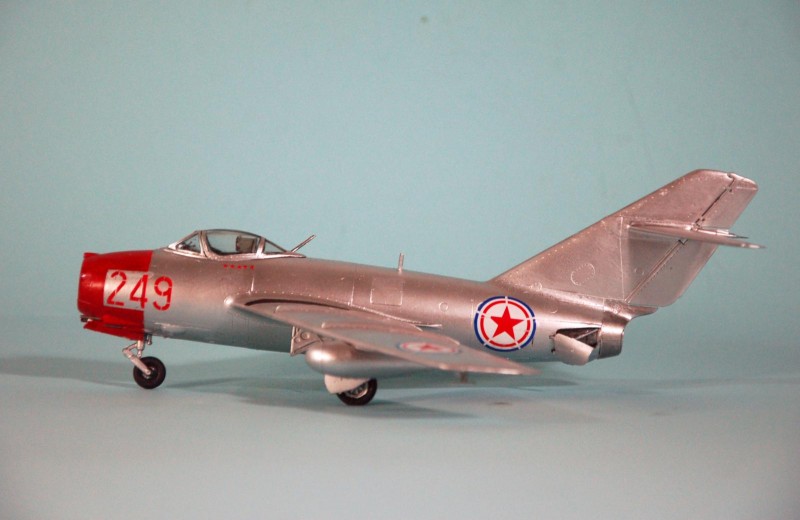
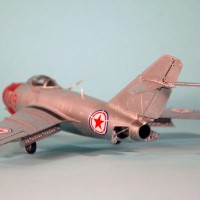
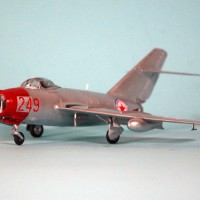
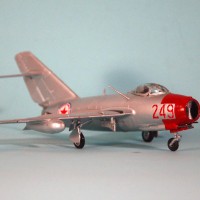
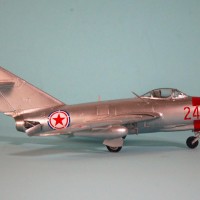
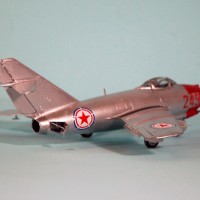
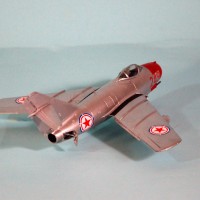

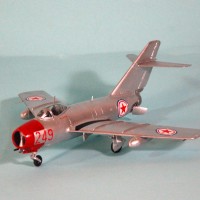
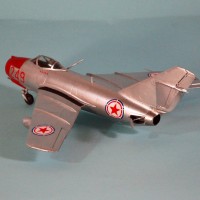
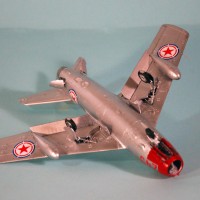
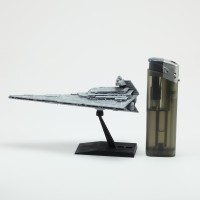
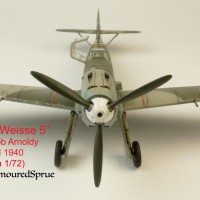
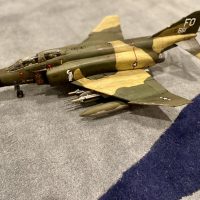
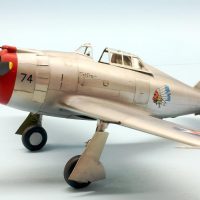
Nice build and great history read!
The background story is a splendid motivation to get a Sabre and one these MiGs and go about building them for dogfight diorama. Great work Tom
Politicians eh enough said. Nice build.
As usual, the history lesson is awesome, Tom! I really appreciate the time you take to present the "backstory" to your builds. They ALWAYS hold my interest !
Well done, Sir!
Thank you very much, Jeff
The Korean War used to be called (for some) a police action and was one of the first proxy wars for Stalin to show the hardware and see how well it did against the West. Fortunately, Stalin passed away. However, towards the end of active hostilities the Russians had developed the Mig-17 but, chose not to put in theater. At least cooler minds thought better of it thanks to Stalin and Truman for keeping a lid on things.
I find that Trumpeter does a decent job of doing Chinese made aircraft ...one would like to think given all of the examples found in museums in China. As always another interesting, informative and article and build TC. In short good writing...
Nice build, and love the story!
Very nice Tom. I wasn't aware of the outline issue, thanks for the heads up as I want to add one of these aircraft. I am slowly building up my stock of Vallejo paints. I've just finished painting a 1:48 Nakajima B6N2 "Jill" using an old bottle of Chrome. I'll post some photos later in the week